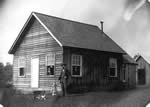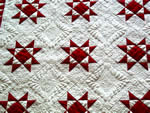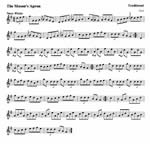Christmas in the Gold Fields
by Gary Noy
Center for Sierra Nevada Studies
The Holiday Season was always highly anticipated during the California Gold Rush years. The celebrations were pure mid-19th Century Americana, but with a twist. The extraordinary nature of this worldwide event and the fact that many who participated in the Gold Rush were young and far from home added to the intensity with which the holiday was celebrated. In its earliest days, the Gold Rush was almost exclusively male and the sentiment was a mixture of homesickness and “boys will be boys” revelry. Christmas in the gold fields could be a day of lonely reflection or frantic carousing, but it was always a day that the gold seekers remembered well.
A Gold Rush Christmas was usually an unassuming, often spontaneous affair that consisted primarily of eating, drinking, convivial companionship and entertainment. Although, in the mid-19th century, gift giving was becoming fashionable primarily due to the popularity of the practice in the Victorian Royal Court, Christmas Gifts during the Gold Rush are rarely mentioned.  However, if there were presents in the gold fields, they were practical in nature. Knitted socks were always prized, as were scarves or mittens. In the towns where there were children, little girls might receive homemade rag dolls and miniature quilts, while little boys received tops or other wooden toys lovingly carved by their friends and family.
However, if there were presents in the gold fields, they were practical in nature. Knitted socks were always prized, as were scarves or mittens. In the towns where there were children, little girls might receive homemade rag dolls and miniature quilts, while little boys received tops or other wooden toys lovingly carved by their friends and family.
Presents and Parties
Often Christmas represented the only time when some people, both adults and children, received presents or had parties. As a result, the holiday held an important place in the hearts, minds, and memories of 19th century folk.
There are many accounts of Christmas festivities in the gold fields - most modest, some complicated, but all heartfelt.
Andrew Hall Gilmore penned an example of a humble, hardworking holiday on Christmas Day 1851 in a letter to his brother in Indiana:
Thursday night - 25th
Dear Brother,
"Christmas Gift to You." Oh, I wish that I could be at home today. I think we would have a Christmas party. We would have the old gobbler roasted with a score of fat hens, pound cakes, pies, and lots of other good things. But the best of all would be the pleasure of seeing you all. Probably if we live we may be with you next Christmas.
I will tell you what kind of a day it has been and what we have been doing. It has been the most rainy day I believe that I have ever seen in this country. … As we had no invitations to any Christmas parties: and feeling no inclination to go on a "bust", we thought we might spend the day as profitably by going down to our diggings and working like fine fellows, even if it was Christmas and awful rainy at that. So Aaron and I encased ourselves in our waterproof suits and went to work …. We made $11.25 each, which was a tolerably good rainy day's work …
Christmas in Rich Bar
An elaborate Christmas (that was more a reward for perseverance than anything) was described by Louise Amelia Knapp Smith Clappe in 1851. Better known as Dame Shirley, Clappe wrote a series of letters describing her life in the Gold Rush community of Rich Bar, which was located in the Feather River Gorge. These letters are considered one of the best eyewitness accounts of the California Gold Rush. Here, Dame Shirley recalls the “Saturnalia” of Christmas 1851:
The saturnalia commenced on Christmas evening, at the Humboldt [Saloon], which, on that very day, had passed into the hands of new proprietors. The most gorgeous preparations were made for celebrating the two events. The bar was retrimmed with red calico, the bowling-alley had a new lining of the coarsest and whitest cotton cloth, and the broken lamp-shades were replaced by whole ones. All day long, patient mules could be seen descending the hill, bending beneath casks of brandy and baskets of champagne, and, for the first time in the history of that celebrated building, the floor (wonderful to relate, it has a floor) was washed …. At nine o'clock in the evening they had an oyster-and-champagne supper in the Humboldt, which was very gay with toasts, songs, speeches, etc. I believe that the company danced all night. At any rate, they were dancing when I went to sleep, and they were dancing when I woke the next morning. The revel was kept up in this mad way for three days, growing wilder every hour.
Christmas Spree and the Christmas Nugget
Alfred Doten, well known chronicler of the Gold Rush, friend of Mark Twain, and widely renowned as a leading “reveler,” described Christmas of 1853. In this account Doten found himself in Amador County, where he threw a “Christmas Spree” which featured “a glorious game supper of fried deer tongue, liver, quails, and hares” washed downed with barrels of cognac and accompanied by violin, flute, banjo, clarinet and accordion music.
But the most delightful Gold Rush Christmas story is that of the “Christmas Nugget” recounted in William P. Bennett’s 1893 memoir of the California Gold Rush entitled The First Baby in Camp.
On Christmas Day, 1849, Mrs. William George Wilson delivered a healthy, 12-pound boy at Canyon Creek, near Georgetown. Soon a neighboring claim and the gold field grapevine had spread the tongue-in-cheek news that Bill Wilson had struck it rich and found a twelve-pound nugget. Most took the news literally, however. “News of the big find spread like wildfire up and down the canyon where hundreds of men were at work," wrote Bennett, "At once, there was a grand rush to Bill Wilson's cabin. Every miner was anxious to see the 12-pound lump."
The Wilsons thoroughly enjoyed the moment and lined up the men at the cabin door. A few were let in at a time to view the “nugget.”
"Each of the miners loved being had," Bennett recalled, "As each squad came out of the cabin, the men solemnly asserted that the Wilson nugget was the finest ever seen."
For three more days, the joke continued throughout the area. Bennett wrote of miners who came from more than ten miles away to see the giant “Christmas Nugget.”
Gallery








